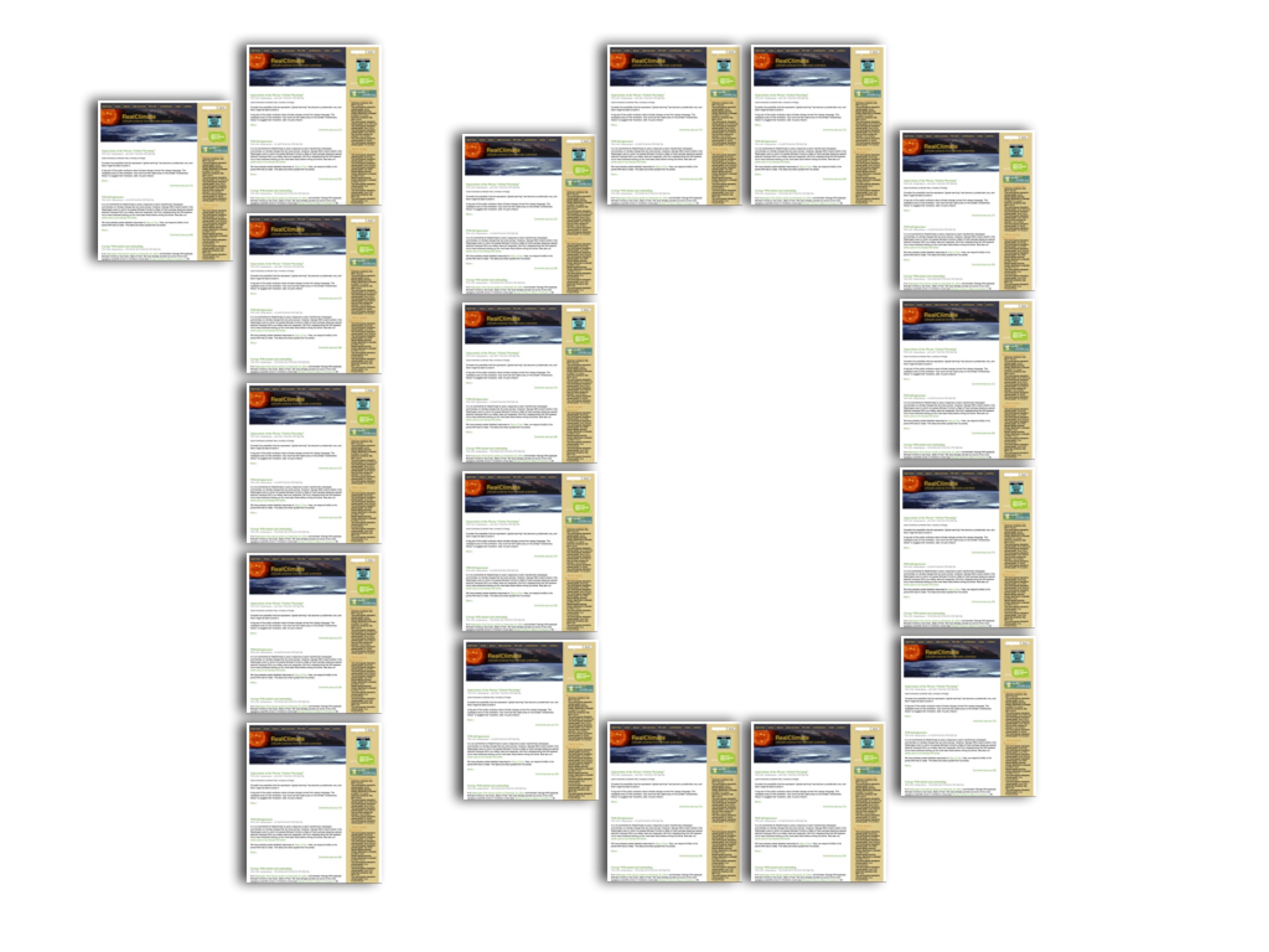This month’s open thread. Sorry for the slow start – you know what it’s like after the holidays…
AGU 2014
Once more unto the breach!
Fall AGU this year will be (as last year)
…the largest Earth Science conference on the planet, and is where you will get previews of new science results, get a sense of what other experts think about current topics, and indulge in the more social side of being a scientist.
Ten Years of RealClimate: Where now?

Ten Years of RealClimate

Ten years of RealClimate: Thanks

The 90+ guest contributors and previous team members who bring a necessary diversity of experience and expertise to the blog: Abby Swann, Alan Robock, Anders Levermann, Andrew Monaghan, Andy Baker, Andy Dessler, Axel Schweiger, Barry Bickmore, Bart Strengers, Bart Verheggen, Beate Liepert, Ben Santer, Brian Helmuth, Brian Soden, Brigitte Knopf, Caspar Ammann, Cecilia Bitz, Chris Colose, Christopher Hennon, Corrine LeQuere, Darrell Kaufman, David Briske, David Karoly, David Ritson, David Vaughan, Dim Coumou, Dirk Notz, Dorothy Koch, Drew Shindell, Ed Hawkins, Eugenie Scott, Figen Mekik, Francisco Doblas-Reyes, Frank Zeman, Geert Jan van Oldenborgh, Georg Feulner, Georg Hoffmann, George Tselioudis, Jacob Harold, Jared Rennie, Jason West, Jeffrey Pierce, Jim Bouldin, Jim Prall, John Fasullo, Joy Shumake-Guillemot, Juliane Fry, Karen Shell, Keith Briffa, Kelly Levin, Kevin Brown, Kevin Trenberth, Kim Cobb, Kyle Swanson, Loretta Mickley, Marco Tedesco, Mark Boslough, Martin Manning, Martin Vermeer, Matt King, Matthew England, Mauri Pelto, Michael Bentley, Michael Oppenheimer, Michael Tobis, Michelle L’Heureux, Natassa Romanou, Paul Higgins, Peter Minnett, Phil Jones, Pippa Whitehouse, PubPeer, Raimund Muscheler, Rein Haarsma, Richard Millar, Robert Rohde, Ron Lindsay, Ron Miller, Russell Seitz, Sarah Feakins, Scott Mandia, Scott Saleska, Simon Lewis, Spencer Weart, Stephen Schneider, Steve Ghan, Steve Sherwood, Sybren Drijfhout, Tad Pfeffer, Tamino, Terry Gerlach, Thibault de Garidel, Thomas Crowley, Tim Osborn, Tom Melvin, Urs Neu, Vicky Slonosky, William Anderegg, William Connolley and Zeke Hausfather;
The thousands of commenters that have enlivened the conversation and explored many issues in more depth than is possible in the main posts;
The translators of hundreds of posts into Polish, French, Czech, German, Italian, Spanish, Turkish, Mandarin etc;
Miloslav Nic for his “Guide to RC” which provides a comprehensive set of indexes to the content here;
Ryan and the internet service providers at Peer, and now Webfaction, that have helped deal with the many technical challenges and to Environmental Media Services and later, the Science Communication Network, for covering some of those costs;
A sincere thanks to all.
Ten years of Realclimate: By the numbers

Number of posts: 914
Number of comments: ~172,000
Number of comments with inline responses: 14,277
Minimum number of total unique page visits, and unique views, respectively: 19 Million, 35 Million
Number of guest posts: 100+
Number of mentions in newspaper sources indexed by LexisNexis: 225
Minimum number of contributors and guest authors: 105
Minimum number of times RealClimate was hacked: 2
Busiest month: December 2009
Busiest day of the week: Monday
Number of times the IPCC and the NIPCC are mentioned, respectively: 357, 5
Minimum number of Science papers arising from a blog post here: 1
Minimum number of RealClimate mentions in Web Of Science references: 14
Minimum number of RealClimate mentions in theses indexed by ProQuest: 33
Posts highest ranked by Google by year:
All numbers are estimates from latest available data, but no warranty is implied or provided so all use of these numbers is at your own risk.
Unforced variations: Dec 2014
Unforced variations: Nov 2014
This month’s open thread. In honour of today’s New York Marathon, we are expecting the fastest of you to read and digest the final IPCC Synthesis report in sub-3 hours. For those who didn’t keep up with the IPCC training regime, the Summary for Policy Makers provides a more accessible target.
Also in the news, follow #ArcticCircle2014 for some great info on the Arctic Circle meeting in Iceland.
Storm surge: Hurricane Sandy

How do trees change the climate?
Guest commentary from Abby Swann (U. Washington)
This past month, an op-ed by Nadine Unger appeared in the New York Times with the headline “To save the climate, don’t plant trees”. The author’s main argument is that UN programs to address climate change by planting trees or preserving existing forests are “high risk” and a “bad bet”. [Ed. There is more background on the op-ed here]
However, I don’t think that these conclusions are supported by the science. The author connects unrelated issues about trees, conflates what we know about trees from different latitudes, and fails to convey the main point: tropical trees keep climate cool locally, help keep rainfall rates high, and have innumerable non-climate benefits including maintaining habitat and supporting biodiversity.